+ Open data
Open data
- Basic information
Basic information
| Entry | Database: PDB / ID: 5of4 | |||||||||
|---|---|---|---|---|---|---|---|---|---|---|
| Title | The cryo-EM structure of human TFIIH | |||||||||
 Components Components |
| |||||||||
 Keywords Keywords |  TRANSCRIPTION / TRANSCRIPTION /  transcription initiation / transcription initiation /  DNA repair / DNA repair /  multiprotein complex / multiprotein complex /  kinase / kinase /  helicase helicase | |||||||||
| Function / homology |  Function and homology information Function and homology informationMMXD complex / core TFIIH complex portion of holo TFIIH complex / positive regulation of DNA helicase activity / Cytosolic iron-sulfur cluster assembly / nucleotide-excision repair, DNA duplex unwinding /  central nervous system myelin formation / positive regulation of mitotic recombination / hair cell differentiation / hair follicle maturation / nucleotide-excision repair factor 3 complex ...MMXD complex / core TFIIH complex portion of holo TFIIH complex / positive regulation of DNA helicase activity / Cytosolic iron-sulfur cluster assembly / nucleotide-excision repair, DNA duplex unwinding / central nervous system myelin formation / positive regulation of mitotic recombination / hair cell differentiation / hair follicle maturation / nucleotide-excision repair factor 3 complex ...MMXD complex / core TFIIH complex portion of holo TFIIH complex / positive regulation of DNA helicase activity / Cytosolic iron-sulfur cluster assembly / nucleotide-excision repair, DNA duplex unwinding /  central nervous system myelin formation / positive regulation of mitotic recombination / hair cell differentiation / hair follicle maturation / nucleotide-excision repair factor 3 complex / nucleotide-excision repair, preincision complex assembly / central nervous system myelin formation / positive regulation of mitotic recombination / hair cell differentiation / hair follicle maturation / nucleotide-excision repair factor 3 complex / nucleotide-excision repair, preincision complex assembly /  UV protection / CAK-ERCC2 complex / embryonic cleavage / 5'-3' DNA helicase activity / G protein-coupled receptor internalization / transcription factor TFIIH holo complex / transcription factor TFIIH core complex / 3'-5' DNA helicase activity / UV protection / CAK-ERCC2 complex / embryonic cleavage / 5'-3' DNA helicase activity / G protein-coupled receptor internalization / transcription factor TFIIH holo complex / transcription factor TFIIH core complex / 3'-5' DNA helicase activity /  transcription preinitiation complex / RNA Polymerase I Transcription Termination / regulation of mitotic cell cycle phase transition / hematopoietic stem cell proliferation / RNA Pol II CTD phosphorylation and interaction with CE during HIV infection / RNA Pol II CTD phosphorylation and interaction with CE / spinal cord development / RNA polymerase II general transcription initiation factor activity / transcription factor TFIID complex / Formation of the Early Elongation Complex / Formation of the HIV-1 Early Elongation Complex / mRNA Capping / transcription preinitiation complex / RNA Polymerase I Transcription Termination / regulation of mitotic cell cycle phase transition / hematopoietic stem cell proliferation / RNA Pol II CTD phosphorylation and interaction with CE during HIV infection / RNA Pol II CTD phosphorylation and interaction with CE / spinal cord development / RNA polymerase II general transcription initiation factor activity / transcription factor TFIID complex / Formation of the Early Elongation Complex / Formation of the HIV-1 Early Elongation Complex / mRNA Capping /  bone mineralization / HIV Transcription Initiation / RNA Polymerase II HIV Promoter Escape / Transcription of the HIV genome / RNA Polymerase II Promoter Escape / RNA Polymerase II Transcription Pre-Initiation And Promoter Opening / RNA Polymerase II Transcription Initiation / RNA Polymerase II Transcription Initiation And Promoter Clearance / erythrocyte maturation / ATPase activator activity / RNA Polymerase I Transcription Initiation / transcription elongation by RNA polymerase I / DNA topological change / intrinsic apoptotic signaling pathway by p53 class mediator / transcription-coupled nucleotide-excision repair / hematopoietic stem cell differentiation / Tat-mediated elongation of the HIV-1 transcript / Formation of HIV-1 elongation complex containing HIV-1 Tat / embryonic organ development / Formation of HIV elongation complex in the absence of HIV Tat / RNA Polymerase II Transcription Elongation / Formation of RNA Pol II elongation complex / maturation of SSU-rRNA from tricistronic rRNA transcript (SSU-rRNA, 5.8S rRNA, LSU-rRNA) / response to UV / RNA Polymerase II Pre-transcription Events / bone mineralization / HIV Transcription Initiation / RNA Polymerase II HIV Promoter Escape / Transcription of the HIV genome / RNA Polymerase II Promoter Escape / RNA Polymerase II Transcription Pre-Initiation And Promoter Opening / RNA Polymerase II Transcription Initiation / RNA Polymerase II Transcription Initiation And Promoter Clearance / erythrocyte maturation / ATPase activator activity / RNA Polymerase I Transcription Initiation / transcription elongation by RNA polymerase I / DNA topological change / intrinsic apoptotic signaling pathway by p53 class mediator / transcription-coupled nucleotide-excision repair / hematopoietic stem cell differentiation / Tat-mediated elongation of the HIV-1 transcript / Formation of HIV-1 elongation complex containing HIV-1 Tat / embryonic organ development / Formation of HIV elongation complex in the absence of HIV Tat / RNA Polymerase II Transcription Elongation / Formation of RNA Pol II elongation complex / maturation of SSU-rRNA from tricistronic rRNA transcript (SSU-rRNA, 5.8S rRNA, LSU-rRNA) / response to UV / RNA Polymerase II Pre-transcription Events /  DNA helicase activity / extracellular matrix organization / post-embryonic development / insulin-like growth factor receptor signaling pathway / DNA helicase activity / extracellular matrix organization / post-embryonic development / insulin-like growth factor receptor signaling pathway /  chromosome segregation / determination of adult lifespan / promoter-specific chromatin binding / transcription elongation by RNA polymerase II / chromosome segregation / determination of adult lifespan / promoter-specific chromatin binding / transcription elongation by RNA polymerase II /  transcription initiation at RNA polymerase II promoter / nucleotide-excision repair / RNA Polymerase I Promoter Escape / TP53 Regulates Transcription of DNA Repair Genes / multicellular organism growth / cellular response to gamma radiation / NoRC negatively regulates rRNA expression / transcription initiation at RNA polymerase II promoter / nucleotide-excision repair / RNA Polymerase I Promoter Escape / TP53 Regulates Transcription of DNA Repair Genes / multicellular organism growth / cellular response to gamma radiation / NoRC negatively regulates rRNA expression /  protein localization / Dual Incision in GG-NER / Transcription-Coupled Nucleotide Excision Repair (TC-NER) / spindle / Formation of TC-NER Pre-Incision Complex / Formation of Incision Complex in GG-NER / Dual incision in TC-NER / Gap-filling DNA repair synthesis and ligation in TC-NER / protein-macromolecule adaptor activity / 4 iron, 4 sulfur cluster binding / protein localization / Dual Incision in GG-NER / Transcription-Coupled Nucleotide Excision Repair (TC-NER) / spindle / Formation of TC-NER Pre-Incision Complex / Formation of Incision Complex in GG-NER / Dual incision in TC-NER / Gap-filling DNA repair synthesis and ligation in TC-NER / protein-macromolecule adaptor activity / 4 iron, 4 sulfur cluster binding /  double-stranded DNA binding / double-stranded DNA binding /  DNA helicase / response to oxidative stress / in utero embryonic development / transcription by RNA polymerase II / damaged DNA binding / response to hypoxia / nuclear speck / positive regulation of apoptotic process / DNA helicase / response to oxidative stress / in utero embryonic development / transcription by RNA polymerase II / damaged DNA binding / response to hypoxia / nuclear speck / positive regulation of apoptotic process /  DNA repair / apoptotic process / DNA repair / apoptotic process /  nucleolus / regulation of DNA-templated transcription / regulation of transcription by RNA polymerase II / nucleolus / regulation of DNA-templated transcription / regulation of transcription by RNA polymerase II /  ATP hydrolysis activity / ATP hydrolysis activity /  DNA binding / zinc ion binding / DNA binding / zinc ion binding /  nucleoplasm / nucleoplasm /  ATP binding ATP bindingSimilarity search - Function | |||||||||
| Biological species |   Homo sapiens (human) Homo sapiens (human) | |||||||||
| Method |  ELECTRON MICROSCOPY / ELECTRON MICROSCOPY /  single particle reconstruction / single particle reconstruction /  cryo EM / Resolution: 4.4 Å cryo EM / Resolution: 4.4 Å | |||||||||
 Authors Authors | Greber, B.J. / Nguyen, T.H.D. / Fang, J. / Afonine, P.V. / Adams, P.D. / Nogales, E. | |||||||||
| Funding support |  United States, 2items United States, 2items
| |||||||||
 Citation Citation |  Journal: Nature / Year: 2017 Journal: Nature / Year: 2017Title: The cryo-electron microscopy structure of human transcription factor IIH. Authors: Basil J Greber / Thi Hoang Duong Nguyen / Jie Fang / Pavel V Afonine / Paul D Adams / Eva Nogales /  Abstract: Human transcription factor IIH (TFIIH) is part of the general transcriptional machinery required by RNA polymerase II for the initiation of eukaryotic gene transcription. Composed of ten subunits ...Human transcription factor IIH (TFIIH) is part of the general transcriptional machinery required by RNA polymerase II for the initiation of eukaryotic gene transcription. Composed of ten subunits that add up to a molecular mass of about 500 kDa, TFIIH is also essential for nucleotide excision repair. The seven-subunit TFIIH core complex formed by XPB, XPD, p62, p52, p44, p34, and p8 is competent for DNA repair, while the CDK-activating kinase subcomplex, which includes the kinase activity of CDK7 as well as the cyclin H and MAT1 subunits, is additionally required for transcription initiation. Mutations in the TFIIH subunits XPB, XPD, and p8 lead to severe premature ageing and cancer propensity in the genetic diseases xeroderma pigmentosum, Cockayne syndrome, and trichothiodystrophy, highlighting the importance of TFIIH for cellular physiology. Here we present the cryo-electron microscopy structure of human TFIIH at 4.4 Å resolution. The structure reveals the molecular architecture of the TFIIH core complex, the detailed structures of its constituent XPB and XPD ATPases, and how the core and kinase subcomplexes of TFIIH are connected. Additionally, our structure provides insight into the conformational dynamics of TFIIH and the regulation of its activity. | |||||||||
| History |
|
- Structure visualization
Structure visualization
| Movie |
 Movie viewer Movie viewer |
|---|---|
| Structure viewer | Molecule:  Molmil Molmil Jmol/JSmol Jmol/JSmol |
- Downloads & links
Downloads & links
- Download
Download
| PDBx/mmCIF format |  5of4.cif.gz 5of4.cif.gz | 453.5 KB | Display |  PDBx/mmCIF format PDBx/mmCIF format |
|---|---|---|---|---|
| PDB format |  pdb5of4.ent.gz pdb5of4.ent.gz | 363.1 KB | Display |  PDB format PDB format |
| PDBx/mmJSON format |  5of4.json.gz 5of4.json.gz | Tree view |  PDBx/mmJSON format PDBx/mmJSON format | |
| Others |  Other downloads Other downloads |
-Validation report
| Arichive directory |  https://data.pdbj.org/pub/pdb/validation_reports/of/5of4 https://data.pdbj.org/pub/pdb/validation_reports/of/5of4 ftp://data.pdbj.org/pub/pdb/validation_reports/of/5of4 ftp://data.pdbj.org/pub/pdb/validation_reports/of/5of4 | HTTPS FTP |
|---|
-Related structure data
| Related structure data |  3802MC  8816C  8817C M: map data used to model this data C: citing same article ( |
|---|---|
| Similar structure data |
- Links
Links
- Assembly
Assembly
| Deposited unit | 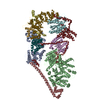
|
|---|---|
| 1 |
|
- Components
Components
-TFIIH basal transcription factor complex helicase ... , 2 types, 2 molecules AB
| #1: Protein | Mass: 62426.047 Da / Num. of mol.: 1 / Source method: isolated from a natural source / Source: (natural)   Homo sapiens (human) / Cell line: HeLa / References: UniProt: P19447, Homo sapiens (human) / Cell line: HeLa / References: UniProt: P19447,  DNA helicase DNA helicase |
|---|---|
| #2: Protein | Mass: 87021.078 Da / Num. of mol.: 1 / Source method: isolated from a natural source / Source: (natural)   Homo sapiens (human) / Cell line: HeLa / References: UniProt: P18074, Homo sapiens (human) / Cell line: HeLa / References: UniProt: P18074,  DNA helicase DNA helicase |
-General transcription factor IIH subunit ... , 4 types, 4 molecules DEFG
| #3: Protein | Mass: 9875.401 Da / Num. of mol.: 1 / Source method: isolated from a natural source / Source: (natural)   Homo sapiens (human) / Cell line: HeLa / References: UniProt: Q92759 Homo sapiens (human) / Cell line: HeLa / References: UniProt: Q92759 |
|---|---|
| #4: Protein | Mass: 44481.996 Da / Num. of mol.: 1 / Source method: isolated from a natural source / Source: (natural)   Homo sapiens (human) / Cell line: HeLa / References: UniProt: Q13888 Homo sapiens (human) / Cell line: HeLa / References: UniProt: Q13888 |
| #5: Protein | Mass: 34416.008 Da / Num. of mol.: 1 / Source method: isolated from a natural source / Source: (natural)   Homo sapiens (human) / Cell line: HeLa / References: UniProt: Q13889 Homo sapiens (human) / Cell line: HeLa / References: UniProt: Q13889 |
| #6: Protein | Mass: 8060.362 Da / Num. of mol.: 1 / Source method: isolated from a natural source / Source: (natural)   Homo sapiens (human) / Cell line: HeLa / References: UniProt: Q6ZYL4 Homo sapiens (human) / Cell line: HeLa / References: UniProt: Q6ZYL4 |
-Protein , 2 types, 2 molecules HZ
| #7: Protein | Mass: 10571.022 Da / Num. of mol.: 1 / Source method: isolated from a natural source / Details: Sequence register unassigned. / Source: (natural)   Homo sapiens (human) Homo sapiens (human) |
|---|---|
| #8: Protein | Mass: 22996.232 Da / Num. of mol.: 1 / Source method: isolated from a natural source / Details: Sequence unassigned. / Source: (natural)   Homo sapiens (human) Homo sapiens (human) |
-Unassigned secondary structure elements ... , 2 types, 2 molecules YX
| #9: Protein | Mass: 19762.281 Da / Num. of mol.: 1 / Source method: isolated from a natural source / Details: Sequence unassigned / Source: (natural)   Homo sapiens (human) Homo sapiens (human) |
|---|---|
| #10: Protein | Mass: 6656.196 Da / Num. of mol.: 1 / Source method: isolated from a natural source / Source: (natural)   Homo sapiens (human) Homo sapiens (human) |
-Non-polymers , 1 types, 1 molecules 
| #11: Chemical | ChemComp-SF4 /  Iron–sulfur cluster Iron–sulfur cluster |
|---|
-Experimental details
-Experiment
| Experiment | Method:  ELECTRON MICROSCOPY ELECTRON MICROSCOPY |
|---|---|
| EM experiment | Aggregation state: PARTICLE / 3D reconstruction method:  single particle reconstruction single particle reconstruction |
- Sample preparation
Sample preparation
| Component |
| ||||||||||||||||||||||||||||||||||||||||
|---|---|---|---|---|---|---|---|---|---|---|---|---|---|---|---|---|---|---|---|---|---|---|---|---|---|---|---|---|---|---|---|---|---|---|---|---|---|---|---|---|---|
| Molecular weight |
| ||||||||||||||||||||||||||||||||||||||||
| Source (natural) |
| ||||||||||||||||||||||||||||||||||||||||
| Buffer solution | pH: 7.8 | ||||||||||||||||||||||||||||||||||||||||
| Buffer component |
| ||||||||||||||||||||||||||||||||||||||||
| Specimen | Conc.: 0.0049 mg/ml / Embedding applied: NO / Shadowing applied: NO / Staining applied : NO / Vitrification applied : NO / Vitrification applied : YES : YESDetails: Natively purified complex at approx. 10 nM concentration | ||||||||||||||||||||||||||||||||||||||||
| Specimen support | Grid material: COPPER / Grid mesh size: 400 divisions/in. / Grid type: C-flat-4/2 | ||||||||||||||||||||||||||||||||||||||||
Vitrification | Instrument: FEI VITROBOT MARK IV / Cryogen name: ETHANE / Humidity: 100 % / Chamber temperature: 278.15 K / Details: 3-4 minute incubation, 2 second blot |
- Electron microscopy imaging
Electron microscopy imaging
| Microscopy | Model: FEI TITAN |
|---|---|
| Electron gun | Electron source : :  FIELD EMISSION GUN / Accelerating voltage: 300 kV / Illumination mode: FLOOD BEAM FIELD EMISSION GUN / Accelerating voltage: 300 kV / Illumination mode: FLOOD BEAM |
| Electron lens | Mode: BRIGHT FIELD Bright-field microscopy / Calibrated magnification: 37879 X / Nominal defocus max: 4500 nm / Nominal defocus min: 2000 nm / Cs Bright-field microscopy / Calibrated magnification: 37879 X / Nominal defocus max: 4500 nm / Nominal defocus min: 2000 nm / Cs : 2.7 mm / C2 aperture diameter: 50 µm / Alignment procedure: COMA FREE : 2.7 mm / C2 aperture diameter: 50 µm / Alignment procedure: COMA FREE |
| Specimen holder | Cryogen: NITROGEN Specimen holder model: GATAN 626 SINGLE TILT LIQUID NITROGEN CRYO TRANSFER HOLDER |
| Image recording | Average exposure time: 8.7 sec. / Electron dose: 40 e/Å2 / Detector mode: COUNTING / Film or detector model: GATAN K2 SUMMIT (4k x 4k) / Num. of grids imaged: 4 / Num. of real images: 8300 Details: 8300 micrographs collected in four session with identical acquisition settings. Sessions lasted 4, 2, 4, and 4 days and yielded 1200, 1700, 2800, and 2600 micrographs. |
| Image scans | Sampling size: 5 µm / Width: 3840 / Height: 3710 / Movie frames/image: 30 / Used frames/image: 1-30 |
- Processing
Processing
| Software | Name: REFMAC / Version: 5.8.0158 / Classification: refinement | ||||||||||||||||||||||||||||||||||||||||||||||||||||||||||||||||||||||||||||||||||||||||||||||||||||||||||
|---|---|---|---|---|---|---|---|---|---|---|---|---|---|---|---|---|---|---|---|---|---|---|---|---|---|---|---|---|---|---|---|---|---|---|---|---|---|---|---|---|---|---|---|---|---|---|---|---|---|---|---|---|---|---|---|---|---|---|---|---|---|---|---|---|---|---|---|---|---|---|---|---|---|---|---|---|---|---|---|---|---|---|---|---|---|---|---|---|---|---|---|---|---|---|---|---|---|---|---|---|---|---|---|---|---|---|---|
| EM software |
| ||||||||||||||||||||||||||||||||||||||||||||||||||||||||||||||||||||||||||||||||||||||||||||||||||||||||||
| Image processing | Details: Micrographs were inspected for quality of Thon rings and ice contamination. Poor micrographs were rejected. | ||||||||||||||||||||||||||||||||||||||||||||||||||||||||||||||||||||||||||||||||||||||||||||||||||||||||||
CTF correction | Details: Correction in RELION based on values determined in CTFFIND4. Type: PHASE FLIPPING AND AMPLITUDE CORRECTION | ||||||||||||||||||||||||||||||||||||||||||||||||||||||||||||||||||||||||||||||||||||||||||||||||||||||||||
| Particle selection | Num. of particles selected: 1500000 Details: Initial rounds of particle selection using DogPicker within APPION to generate templates for subsequent RELION autopicking. | ||||||||||||||||||||||||||||||||||||||||||||||||||||||||||||||||||||||||||||||||||||||||||||||||||||||||||
| Symmetry | Point symmetry : C1 (asymmetric) : C1 (asymmetric) | ||||||||||||||||||||||||||||||||||||||||||||||||||||||||||||||||||||||||||||||||||||||||||||||||||||||||||
3D reconstruction | Resolution: 4.4 Å / Resolution method: FSC 0.143 CUT-OFF / Num. of particles: 122900 / Algorithm: FOURIER SPACE / Details: RELION 3D auto-refinement (gold standard). / Num. of class averages: 3 / Symmetry type: POINT | ||||||||||||||||||||||||||||||||||||||||||||||||||||||||||||||||||||||||||||||||||||||||||||||||||||||||||
| Atomic model building | Protocol: RIGID BODY FIT / Space: REAL Details: Initial model assembled from high-resolution structures and homology models. Subsequently rebuilt in O and COOT, refined into the cryo-EM map using PHENIX and REFMAC, and fully validated. | ||||||||||||||||||||||||||||||||||||||||||||||||||||||||||||||||||||||||||||||||||||||||||||||||||||||||||
| Refinement | Resolution: 4.4→166.32 Å / Cor.coef. Fo:Fc: 0.939 / SU B: 54.849 / SU ML: 0.668 / ESU R: 1.679 Stereochemistry target values: MAXIMUM LIKELIHOOD WITH PHASES Details: HYDROGENS HAVE BEEN ADDED IN THE RIDING POSITIONS
| ||||||||||||||||||||||||||||||||||||||||||||||||||||||||||||||||||||||||||||||||||||||||||||||||||||||||||
| Solvent computation | Ion probe radii: 0.8 Å / Shrinkage radii: 0.8 Å / VDW probe radii: 1.2 Å / Solvent model: MASK | ||||||||||||||||||||||||||||||||||||||||||||||||||||||||||||||||||||||||||||||||||||||||||||||||||||||||||
| Displacement parameters | Biso mean: 193.578 Å2
| ||||||||||||||||||||||||||||||||||||||||||||||||||||||||||||||||||||||||||||||||||||||||||||||||||||||||||
| Refinement step | Cycle: 1 / Total: 17200 | ||||||||||||||||||||||||||||||||||||||||||||||||||||||||||||||||||||||||||||||||||||||||||||||||||||||||||
| Refine LS restraints |
|
 Movie
Movie Controller
Controller




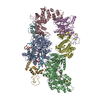
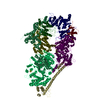

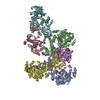
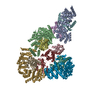
 PDBj
PDBj













